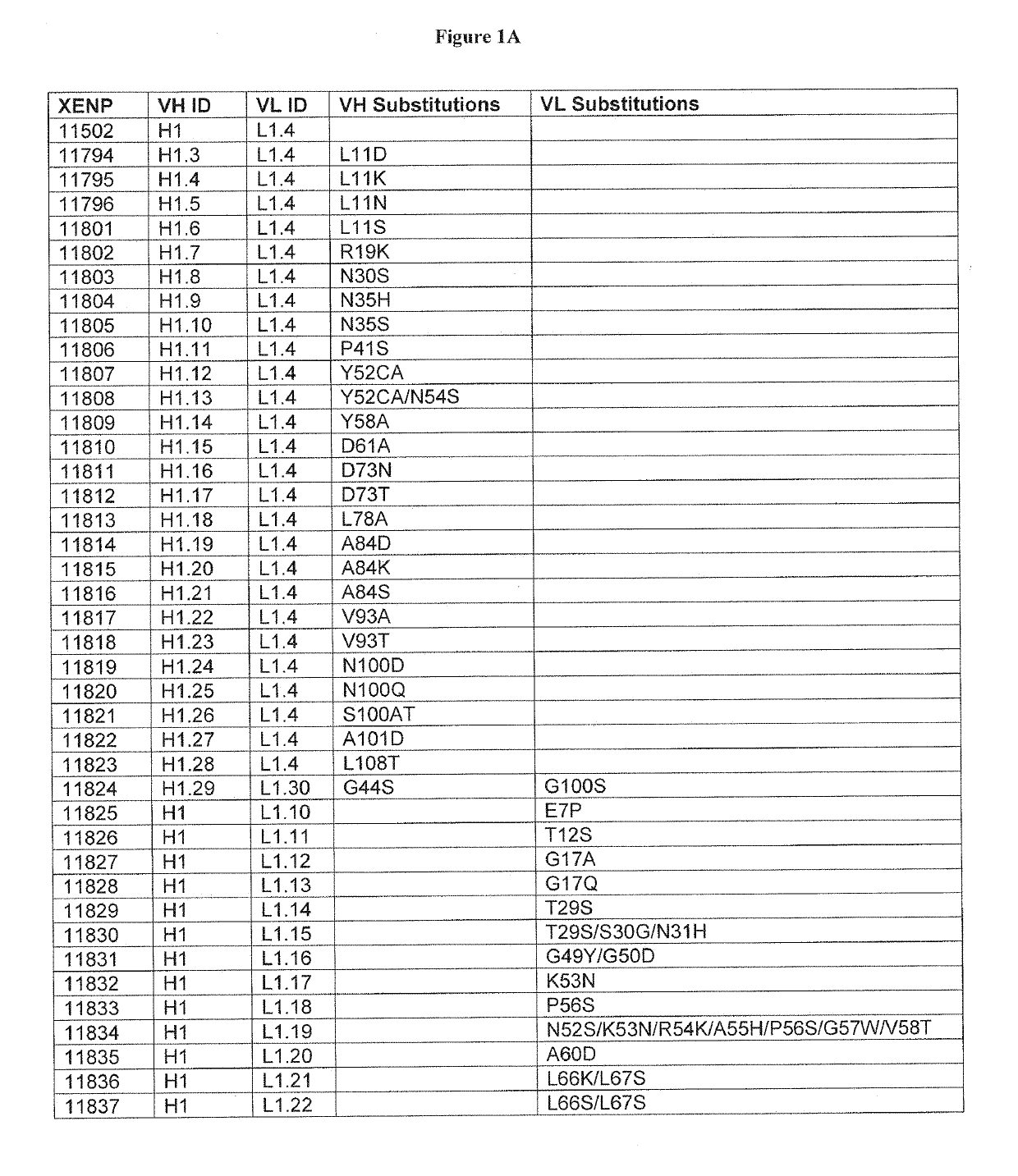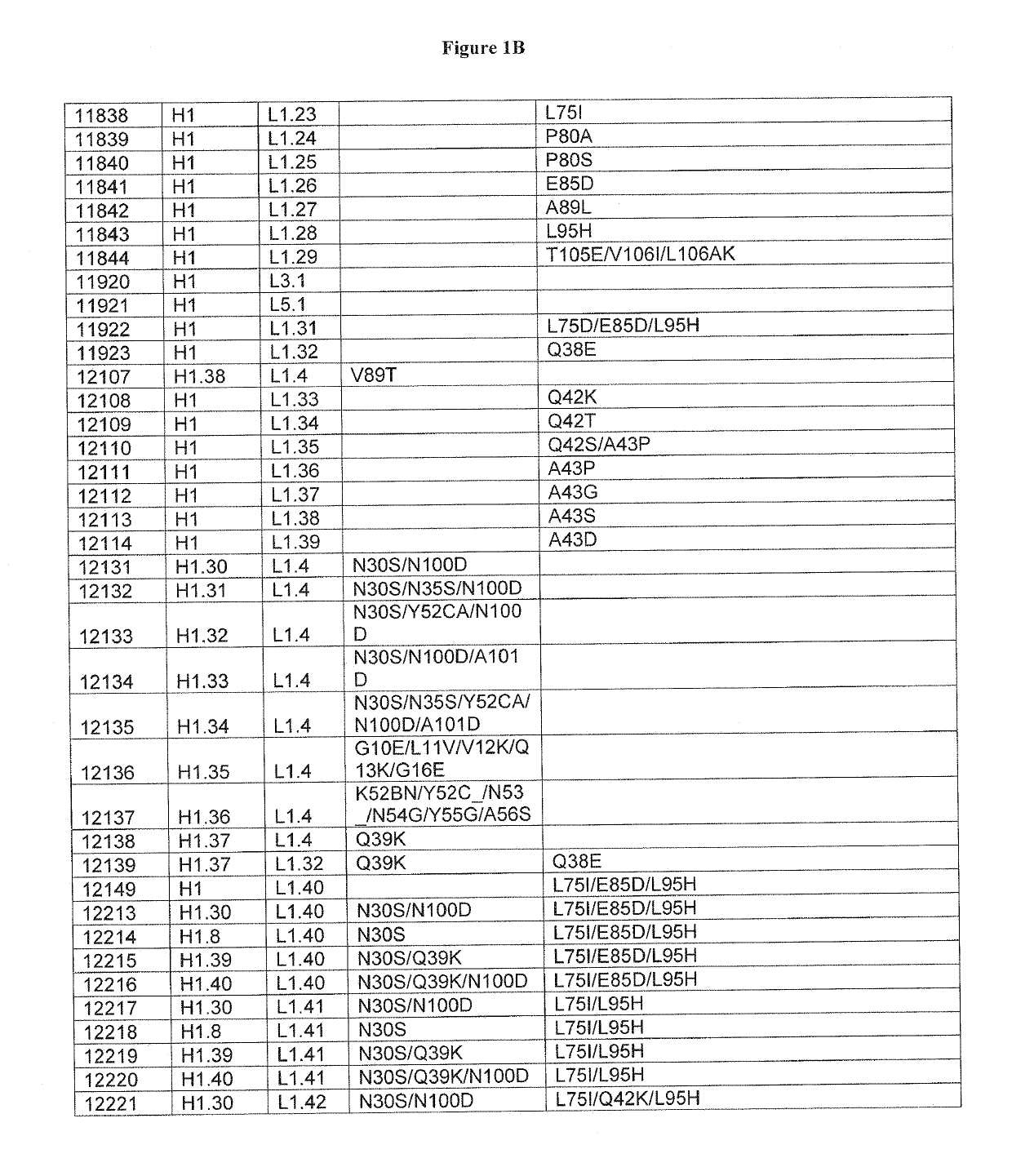Optimized antibody variable regions
- Summary
- Abstract
- Description
- Claims
- Application Information
AI Technical Summary
Benefits of technology
Problems solved by technology
Method used
Image
Examples
example 1
[0371]scFv Production
[0372]DNA encoding the anti-CD3 scFv with a C-terminal GlySer linker and His6-tag was generated by gene synthesis (Blue Heron Biotechnology, Bothell, Wash.) and was subcloned using standard molecular biology techniques into the expression vector pTT5. Substitutions were introduced using either site-directed mutagenesis (QuikChange, Stratagene, Cedar Creek, Tex.) or additional gene synthesis and subcloning using a BspEI restriction site placed in the (Gly4Ser)3 VH-VL linker. DNA was transfected into HEK293E cells for expression and resulting proteins were purified from the supernatant using nickel affinity (Qiagen, Valencia, Calif.) chromatography.
[0373]Determination of Tm
[0374]Differential scanning fluorimetry (DSF) experiments were performed using a Bio-Rad CFX Connect Real-Time PCR Detection System. Proteins were mixed with SYPRO Orange fluorescent dye and diluted to 0.2 mg / mL in PBS. The final concentration of SYPRO Orange was 10×. After an initial 10 minute ...
example 2
[0379]Design of charged scFv linkers to enable IEX purification of scFv containing heterodimeric bispecific antibodies.
[0380]We have previously engineered the antibody constant regions of heterodimeric antibodies to have higher or lower pI using both isotypic and isosteric charge substitutions. These methods enable efficient IEX purification of heterodimeric species, but may impact stability or immunogenicity of the antibodies due to the unnatural substitutions introduced. For scFv containing heterodimeric bispecific antibodies (Examples are shown in FIG. 46), another region to introduce charged substitutions is the scFv linker that connects the VH and VL of scFv constructs. The most common linker used is (GGGGS)3 or (GGGGS)4, which has been shown to be flexible enough to allow stable scFv formation without diabody formation. These sequences are already unnatural, and contain little sequence specificity for likely immunogenic epitopes. Therefore we thought that introducing charged s...
example 3
[0384]Stability and Behavior of scFvs Containing Charged Linkers.
[0385]Anti-CD3 scFv's and anti-CD19 scFv's containing positively or negatively charged linkers, respectively, were evaluated for SEC behavior as well as for stability using DSF. Differential scanning fluorimetry (DSF) was used to evaluate the stability of scFvs containing charged linkers. DSF experiments were performed using a Bio-Rad CFX Connect Real-Time PCR Detection System. Proteins were mixed with SYPRO Orange fluorescent dye and diluted to 0.25 or 0.50 mg / mL in PBS. The final concentration of SYPRO Orange was 10×. After an initial 10 minute incubation period at 25° C., proteins were heated from 25 to 95° C. using a heating rate of 1° C. / min. A fluorescence measurement was taken every 30 sec. Melting temperatures were calculated using the instrument software. Tm values for scFvs are shown in the Figure. Charged linkers had only marginal impacts on overall scFv stability as indicated by their Tm values. SEC chromat...
PUM
| Property | Measurement | Unit |
|---|---|---|
| Volume | aaaaa | aaaaa |
| Mass | aaaaa | aaaaa |
| Mass | aaaaa | aaaaa |
Abstract
Description
Claims
Application Information
 Login to view more
Login to view more - R&D Engineer
- R&D Manager
- IP Professional
- Industry Leading Data Capabilities
- Powerful AI technology
- Patent DNA Extraction
Browse by: Latest US Patents, China's latest patents, Technical Efficacy Thesaurus, Application Domain, Technology Topic.
© 2024 PatSnap. All rights reserved.Legal|Privacy policy|Modern Slavery Act Transparency Statement|Sitemap



